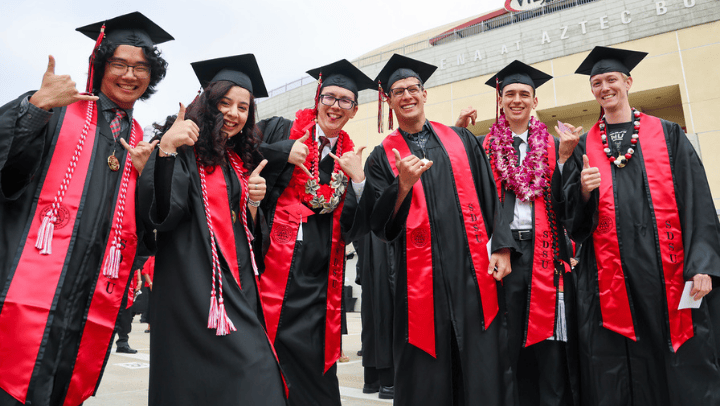SDSU's Response to State Auditors May 14 Report Regarding Mandatory Fees
SDSU's mandatory fees, which are in alignment with law and CSU policy, have resulted in higher student achievement and greater support for academic opportunities.

The California State Auditor released a report on May 14 after auditing the California State University system’s mandatory fees. San Diego State University was among four campuses randomly selected as part of the audit process.
SDSU has remained in full compliance with both federal and state law and as well as California State University (CSU) system policies pertaining to the generation and also the use of funding generated by student fees — and we appreciate that the auditor affirmed this in the report.
The mandatory fees implemented at SDSU have resulted in higher student achievement by supporting additional faculty hires, student-led projects and activities, and by also providing students with academic opportunities that help them to be successful now and in the future.
Mandatory Fee Costs and Compliance
All mandatory fees are approved one of two ways: by a student referendum (vote) or through an alternative consultation process (direct consultation and feedback), which provides a detailed level of feedback from students and student leaders, as well as conversation between students and faculty, staff and administrators.
The period of focus for the audit is the implementation or increase of mandatory fees dating back to 2012. The report discusses two SDSU fees, and mentions a third:
Student Success Fee
Of all Student Success Fee funds, 90 percent is allocated to support the increase of tenure-track faculty and the increase of course availability. Implemented in 2014 via an alternative consultation process, the remainder of the funds are allocated each year to students to financially support student-led academic related programs.
Student Body Center Fee
The Student Body Center Fee was approved via an advisory student referendum in 2018 for implementation during Fall 2021. The fee was implemented for the purpose of expanding and renovating the Aztec Recreation Center, and also adding an additional recreation outdoor field space for the use of all SDSU students.
Instructionally Related Activities Fee
The Instructionally Related Activities Fee is also mentioned in the report. SDSU increased the Instructionally Related Activity Fee, effective for Fall 2020. While the fee proposal included elements of academic success, the fee proposal was appropriately classified as an Instructionally Related Activity fees consistent with how SDSU has classified similar activities and programs in the past and as such CSU fee policy allows for fee approval via either a student referendum or alternative consultation process. The alternative consultation process was used for this fee due to the complexity of the fee, particularly the return to aid component. An alternative consultation process was organized including a series of formal and informal meetings with students through a democratized approach to gather input about the proposed fee, which was later approved.
Use of Mandatory Fees
As evidenced by the CSU’s system-wide Graduation 2025 Initiative, students who are from underrepresented and underserved populations often experience unique challenges that education institutions must address. At SDSU, the faculty and staff educates a culturally, ethnically and economically diverse student body — one of the university's points of pride. The student-supported mandatory fees approved over the years have allowed SDSU to directly address the needs of students from all backgrounds, and to reduce achievement gaps across the student body.
The increased investment in student-focused programs, services and support offered via fee-generated funds were approved either by a student referendum (vote) or an alternative consultation process (direct consultation and feedback from students and student leaders).
Through the use of such fees, SDSU provides student-focused programs and services, and maintains the very facilities students use. The university has also reduced the overall student-to-faculty ratio through additional faculty hires and the addition of course sections through the use of funds generated by mandatory fees — from 24.5:1 in 2014-15 to 22.4:1 in 2018-19.
Mandatory fees support the very high-touch experiences for which SDSU is known, preparing students to be successful academically and professionally: student field trips, student conference participation, student exhibitions, student productions, student performances and also student competitions.
Mandatory fees help ensure that the university is able to offer important and meaningful experiences to our students that help ensure that they are academically prepared and successful, and also workforce ready.
Over the past 10 years, SDSU has seen a rapid increase in its graduation rates. SDSUs 4-year graduation rate for first time freshmen increased from 30% for the entering class of Fall 2009 to 49% for the first-year students who entered SDSU in Fall 2015 and graduated by summer 2019. Most notably 4-year rates increased from 23.2% to 42.3% for under-represented students of color in these cohorts.
Graduation rates for transfer students have also risen. The two-year graduation rate for new transfers has increased from 42.8% for the entering Fall 2009 class to 55.7% for the transfers entering in Fall 2017 and graduating by summer 2019. Similar to freshmen, the two-year graduation rate for under-represented students of color rose from 40.7% to 55.5% when comparing the same cohorts of transfers.
More than half (53%) of CSU bachelor’s degree recipients graduated with zero educational loan debt. Of the 47% with debt, the average loan debt of $17,979 is well below the national average of $29,200 and the California average of $22,585.
Mandatory Fee Oversight
The establishment, oversight and adjustment of student fees is governed by the CSU’s Executive Order 1102. Mandatory student fees are used for the purpose for which the fee was approved, and are not discretionary funds for any campus use. Thus, restrictions are placed on the use of mandatory student fees. Once approved, such fees cannot be repurposed without going through an advisory student referendum or alternative consultation process in accordance with Executive Order 1102.
Further, mandatory student fees are largely expended in the year in which they are collected. However, fees collected to support specific facilities, such as the Student Body Center Fee, which was mentioned in the audit report, may be set-aside for future use specifically in support of large facilities maintenance and repair costs.
Student Assistance
SDSU is committed to supporting the whole student, no matter their background or experience, and that includes aiding financial needs.
Over the last 10 years, SDSU has seen a regular increase in the numbers and amount of scholarship dollars awarded to students. Ten years ago, during the 2008-2009 academic year, SDSU provided a total of 1,649 awards to more than 1,300 students — with some students receiving multiple awards – for a total of $2.6 million awarded.
During the 2018-2019 academic year, more than 3,200 scholarships were awarded to 2,500 students — again, with some receiving more than one award — at more than $6.1 million.
Also, this spring, SDSU launched the Aztec Scholarship Portal, making it easier for students to find and gain scholarship funds.
And understanding that students may need unexpected financial and other support, SDSU also introduced the Economic Crisis Response Team (ECRT) specifically to support students in crisis. The team identifies and provides students with financial and other assistance, including food, housing, care and other needs.



